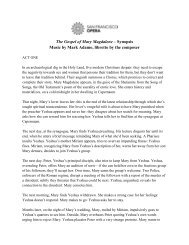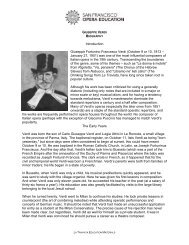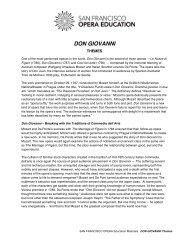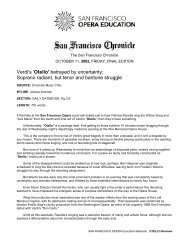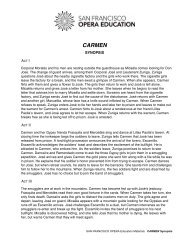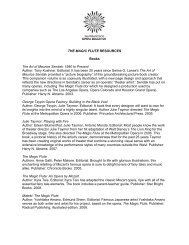Create successful ePaper yourself
Turn your PDF publications into a flip-book with our unique Google optimized e-Paper software.
Mimì's Illness<br />
One of the strongest thematic currents in <strong>La</strong> bohème is Mimì’s illness. It is such a strong<br />
force in the opera that it nearly becomes another character, motivating the action from<br />
beginning to end. It is the force moving underneath her first encounter with Rodolfo, and<br />
colors their relationship from the first moment they meet, through their poverty-plagued life<br />
together, to her death at the end of the opera. What is this illness that haunts this love<br />
story? In 19th-century literature, it was commonly referred to as consumption, The White<br />
Plague of Europe, or the wasting disease. Today we know it as tuberculosis or TB.<br />
Tuberculosis has been around for a very long time. It is a bacterium that has existed<br />
on earth for about 7,000 years and infects many different types of mammals, including<br />
cattle, birds, fish, and even small reptiles. There is no answer to the question of how the<br />
bacterium first got started, but some researchers believe that it might have started as a<br />
micro-organism that once grew in the soil. It shows up in archeological evidence from the<br />
North American continent and from the Asian continent from about 2,000 B.C.E. Ancient<br />
Greek records claim that tuberculosis was the worst of all diseases known at the time. It<br />
first made its debut appearance on the European mainland about 2,500 – 1,500 B.C.E. and<br />
arrived in Britain about 1,000 years after that. In the Dark Ages, and early Middle Ages, it<br />
spread and grew in strength. It was known as the "King's Evil," and it was believed that<br />
only a miracle brought about by the King’s laying on of hands could cure a sick person.<br />
tuberculosis bacterium<br />
In 19th century Europe, consumption, as it was known at the time, ran rampant throughout<br />
society. Since the 18th century one out of every four people living in Europe had died of<br />
the disease. Even in the United States, the death rate was very high, with New York City<br />
one of the worst affected cities in the world. Nineteenth century pianist and composer<br />
Frédéric Chopin (one of George <strong>San</strong>d's lovers – see Bohemians in Paris, 1830) suffered<br />
from the disease, as did a number of famous artists. Of course, there was an epidemic<br />
going on, and literally millions of people were sick, but because the plight of these artists<br />
was publicized, the public began to make a connection between creativity and sickness.<br />
17



